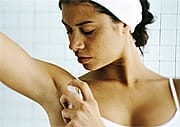Life Extension Magazine®
A cosmetic nuisance endured by women and men is the need to constantly remove body hair. Few people realize how inefficient the shaving process is. Daily shaving chops off only a fraction of the hair shaft, leaving most unwanted hair impacted beneath the skin’s surface, ready to re-emerge within 24 hours. Those who shave daily can spend 100 hours a year running a razor over their delicate skin. An 80-year old who shaves daily from age 15 will spend nine months of their life removing hair using this primitive method. Those who pluck hair squander even more time. Modern methods of hair removal also leave a lot to be desired, as you will soon read. Recognizing that people are removing hair from more parts of their body than ever before, European scientists have developed a topical compound that produced the following results in human clinical trials.1-3
This compound is now available in a soothing topical formula designed to inhibit unwanted hair growth and reduce the time one spends shaving, waxing, plucking, and engaging in other unpleasant forms of hair removal. Unwanted Hair in Today’s World
Whether you’re a man or a woman, your entire body is covered with hair—all except for your lips, the palms of your hands, and the soles of your feet. For many aging women unwanted facial hair is the main problem. The social stigma attached to hirsutism (excess facial or body hair in women) probably reached its height during the Middle Ages when the Malleus Maleficarum or “Hammer of Witches” claimed that facial hair was one of the ways to recognize a witch. But facial hair is quite natural. Every woman has lots of hair follicles hiding below the skin surface of her face. In many cases, these follicles can become over-stimulated by the simple process of aging. Every woman also has a certain amount of male hormones or “androgens” in her body. As some women age, their body produces more of these androgens. This often causes the hair on their chin, upper lip, or neck area to grow. The color and thickness of this hair is largely determined by heredity. So if the women in their family typically have dense, dark, facial hair, they probably will, too. Excess body weight, either alone or accompanied by polycystic ovary syndrome, is another reason women may produce excess androgens. Fat retains androgen, so the heavier a women is, the more androgen she keeps in her body.4,5 In many women, this can also cause a spurt of male-patterned hair growth.
But whatever the reason, if you suffer from this problem—you’re definitely not alone. Unwanted facial hair is more common than you might think: 41 million women in the United States remove unwanted facial hair at least once every six months.6 Twenty percent of these women remove it weekly, and 4% of them remove it every single day. And of course, American women also have to deal with the hair on their legs and underarms. According to one account, the practice of shaving underarms first started in 1915 when sleeveless dresses became popular, and opened up a whole new field of female vulnerability for marketers to exploit. Gillette’s “Great Underarm Campaign” began in May 1915 with an ad in Harper’s Bazaar that was so successful, McCall’s followed suit in 1917. Women’s razors and depilatories started appearing in Sears & Roebuck’s catalog as early as 1922, and America’s obsession with hairless armpits was officially in full swing. Hairless legs didn’t catch on until some years later, however. This was mainly because there wasn’t much practical need for them. After rising in the 1920s, hemlines dropped again in the 1930s and most women were content to just leave their leg hair alone. In the 1940s, however, Betty Grable’s famous WWII pinup plus the rise of shorter skirts and silk stockings (that looked unattractive with leg hair underneath) finally put the issue in the forefront. And that’s how American women got persuaded into shaving their legs and underarms. But What About Men?Most historical accounts credit Alexander the Great as being the one who originally made shaving popular. Alexander obsessed about having a clean-shaven face and would never go into battle with a five o’clock shadow. Julius Caesar also set a mighty example by insisting on having his facial hairs plucked out daily with tweezers. Today 90% of all American males over the age of 15 shave their face. Seventy-five percent of them shave every day. That means the average man will shave his face about 20,000 times between the ages of 15 and 75.7 That’s a lot of time invested in hair removal. Women and men can take now advantage of a recent discovery in the age-old fight against unwanted hair growth. A formulation has evolved to inhibit the time-consuming, boring, and often painful process of eliminating body hair that hasn’t evolved much for mankind in over 6,000 years. Before we reveal this new formulation, let’s explore some facts about hair growth. Getting to the Root of Hair GrowthThe first stage of your hair growth is known as anagen. This growing phase lasts an average of almost three years, but it can range anywhere from two years to six years depending on the individual. During this time, your hair is actively growing at a rate of approximately one centimeter a month (a centimeter is 0.39 inches, or almost one-half of an inch).8 Melanin pigment is also being produced in the hair bulb throughout this entire stage. The next step is a short transition or resting stage called catagen that lasts around two to three weeks. During this time, your hair stops growing. Also at this point, your hair follicle shrinks and part of it begins to die. Only about 4% of your hairs are in this intermediate stage at any given time. In the final or shedding stage (telogen), your hair follicle becomes active once more and starts the cycle of hair growth again. (Each single follicle will produce an average of 20 hairs in its lifetime.) This fresh growth pushes the dead hair up the follicle and expels it to make room for the new hair. It takes roughly three to four months for this particular stage of the process to occur. Only one in ten hair follicles on your head is in this shedding phase at any particular moment. It should be noted that the length of these cycles will vary with the sex of the individual, the person themselves, and the part of the body on which the hair is growing. But one thing is absolutely certain: the key to slowing hair growth lies exclusively in the anagen phase, because only anagen hairs are vulnerable to physical damage or stimuli. Topically applied compounds can now painlessly slow down hair growth—and even decrease hair density so it’s less noticeable. That means you don’t have to shave, wax, or tweeze as often. You can spend the time you save doing something you enjoy instead—all thanks to an exciting new topical formulation.
How Topical Ingredients Suppress Hair GrowthAfter removing your hair (either by mechanical means such as shaving and tweezing or with chemical agents like depilatories), a compound named Decelerine™ penetrates the remaining hair shaft and weakens the hair in the follicle. This causes the new hair to be thinner and of lesser color intensity. Unlike many other ingredients that work in a highly abrasive way (destroying skin cells and hair cells alike), Decelerine™ bases its action on the selective destruction of germinating hair follicle cells during the anagen stage. This tactic effectively inhibits hair growth. The Decelerine™ mixture has been clinically proven to delay the growth of stubborn beard hair by 30% and reduce its density by 16% in just two months.1,2 The results for women are even more impressive. Human clinical studies show Decelerine™ can reduce the frequency of shaving or depilation by up to 82% on the legs, 70% in the groin area, and 50% in the armpits.3 These studies reveal that Decelerine’s mechanism of action in men and women is to target and disrupt the anagen phase of the hair growth cycle. Pseudoalteromonas ferment extract was discovered in the summer of 1988 when a scientific expedition collecting mud samples from an inlet in Antarctica found a new bacterial strain. They named it Pseudoalteromonas antarctica. The scientists found this particular strain of bacteria produced an extracellular material that helped it retain water, adhere to surfaces, and withstand the extreme cold.9-11 This biological adaptation protected the growing bacteria from the extremely harsh environmental conditions they had to endure. When applied to human skin, the natural bio-protective properties of Pseudoalteromonas ferment extract help promote keratinocyte growth and fibroblast adhesion. This unique exopolymer is included in the new hair suppress formula because of its ability to regenerate tissues and protect the skin by enabling faster healing of microscopic irritations, breaks in the skin, and inflammation—all of which can occur during most hair removal techniques (e.g., shaving, waxing, plucking, etc.).
An additional ingredient included in this hair suppress formula is allantoin, which helps moisturize, protect, and soothe your skin. The moisturizing effect of allantoin increases the water content of your skin’s extracellular matrix and also enhances the exfoliation of your dead skin cells, increasing the smoothness of your skin. Allantoin is also a valuable healing agent that stimulates healthy tissue formation. It provides a soothing, anti-irritating, and skin-protecting effect by forming complexes with irritants and sensitizing agents.12 The last ingredient in this new hair-decelerating system is aloe vera. Oddly enough, this cactus-like plant is actually a member of the lily family.13 There are over 300 varieties of aloe, but Aloe barbadensis has the greatest medicinal power. More than 70 active ingredients, including essential oils, amino acids, minerals, vitamins, enzymes, and glycoproteins offer valuable antibiotic, astringent, pain-reducing, growth-supporting, and scar-inhibiting properties14-17 to make aloe vera one of the most important ingredients in the cosmetics industry today. In fact, 95% of the dermatological extracts manufactured around the world feature aloe vera.18 Treasured even before biblical times for its soothing and healing effects on burns and other wounds, aloe vera increases the closure rate of nicks and cuts and improves the tensile strength of wounds by encouraging the proliferation of new cells.14-18 Another reason for aloe vera’s popularity is its incredible moisturizing ability. Aloe vera improves your skin’s hydration, removes dead skin cells, and also acts as a biological vehicle to aid the penetration and absorption of other bioactive ingredients deep into your tissue.14-18 And finally, aloe vera can help improve the look of aging skin and lessen the visual impact of lines, creases, and age spots by stimulating new collagen and elastin synthesis.14-18 The Solution to Unwanted Hair GrowthA new topical formula features active ingredients that inhibit hair growth and decrease the length and density of unwanted hair. Applying this lotion reduces the frequency of shaving, waxing, plucking, or depilation. It also helps your skin recover rapidly with its powerful moisturizing, soothing, and anti-inflammatory effects. This innovative formulation offers a complete post-hair-removal treatment by not only impeding hair growth, but also moisturizing and protecting parts of the skin that are revealed to the world.
If you have any questions on the scientific content of this article, please call a Life Extension Health Advisor at 1-800-226-2370. | ||||||||||
| References | ||||||||||
| 1. www.lipotec.com/ficha.php?producto=41. 2. www.dermoday.com/dosyalar/1234888016.pdf. 3. Lipotec. Data on file. 4. J Clin Endocrinol Metab. 2009 Feb 17. 5. Climacteric. 2008;11(6):509-17. 6. www.medscape.com/viewarticle/412063. 7. www.quikshave.com/statfact.htm. 8. www.pg.com/science/haircare/hair_twh_22.htm. 9. J Colloid Interface Sci. 1997 Aug 15;192(2):286-93. 10. Int J Pharm. 2000 Oct 10;207(1-2):39-47. 11. Environ Microbiol. 2006 Sep;8(9):1523-33. 12. www.thesage.com/catalog/products/Allantoin.html. 13. www.nccam.nih.gov/health/aloevera/. 14. Mol Cell Biochem. 1998 Apr;181(1-2):71-6. 15. Ceska Slov Farm. 2005 Jan;54(1):43-6. 16. J Wound Care. 2004 Apr;13(4):157-8. 17. Clin Hemorheol Microcirc. 2003;29(3-4):239-46. 18. www.healthandaloe.com/Ingles/ingles.htm. 19. www.depilatory.com/core/twentieth.html. |





